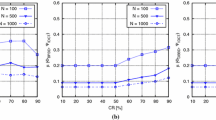The article is devoted to the issues of conceptual development of a new generation of electrocardiogram imitators. A mathematical model is proposed for simulating ECG signal considering the variability of biosignal morphology, the presence of various distortions and artefacts, heart rate variability and respiratory modulation of ECG signal. A block diagram of the ECG simulator was designed.



Similar content being viewed by others
References
R. M. Rangayyan, Biomedical Signal Analysis. Practical Approach [Russian translation], FIZMATLIT, Moscow (2007).
A. A. Fedotov and S. A. Akulov, Mathematical Modeling and Error Analysis of Measuring Transducers of Biomedical Signals, FIZMATLIT, Moscow (2013).
R 50.2.009–2011, State System for Ensuring Uniformity of Measurements. Electrocardiographs, Electrocardioscopes and Electrocardioanalyzers. Verification Methodology, Rostekhregulirovanie, Moscow (2011).
GOST 19687–94, Devices for Measuring the Bioelectric Potentials of the Heart. General Technical Requirements and Test Methods.
P. E. McSharry, P. E. McSharry, G. D. Clifford, et al., “A dynamical model for generating synthetic electrocardiogram signals,” IEEE Trans. Biomed. Eng., 50, No. 3, 289–295 (2003), DOI: https://doi.org/10.1109/TBME.2003.808805.
“Standards of measurement, physiological interpretation and clinical use Task Force of the European Society of Cardiology and North American Society of Pacing and Electrophysiology. Heart rate variability,” Circulation, 93, 1043–1065 (1996).
PhysioNet. Massachusetts Institute of Technology Database, http://physionet.org, acc. May 20, 2018.
J. Boyle, N. Bidargaddi, A. Sarela, and M. Karunanithi, “Automatic detection of respiration rate from ambulatory single-lead ECG,” IEEE Trans. Inform. Technol. Biomed., 16, No. 6, 890–896 (2009).
G. M. Friesen, G. M. Friesen, T. C. Jannett, et al., “A comparison of the noise sensitivity of nine QRS detection algorithms,” IEEE Trans. Biomed. Eng., 27, No. 1, 85–98 (1990), DOI: https://doi.org/10.1109/10.43620.
R. Dev, “Different techniques to remove baseline wander from ECG signal: a review,” Int. J. Electr., Electron. Comm. Eng., 2, No. 7, 532–537 (2012).
H. Han, “Development of real-time motion artifact reduction algorithm for a wearable photoplethysmography,” Proc. 29th Ann. Int. Conf. of the IEEE EMBS (2007), pp. 1539–1541, DOI: https://doi.org/10.1109/IEMBS.2007.4352596.
Author information
Authors and Affiliations
Corresponding author
Additional information
Translated from Izmeritel’naya Tekhnika, No. 12, pp. 59–63, December, 2018.
Rights and permissions
About this article
Cite this article
Fedotov, A.A. The Concept of a New Generation of Electrocardiogram Simulators. Meas Tech 61, 1238–1243 (2019). https://doi.org/10.1007/s11018-019-01576-3
Received:
Published:
Issue Date:
DOI: https://doi.org/10.1007/s11018-019-01576-3




